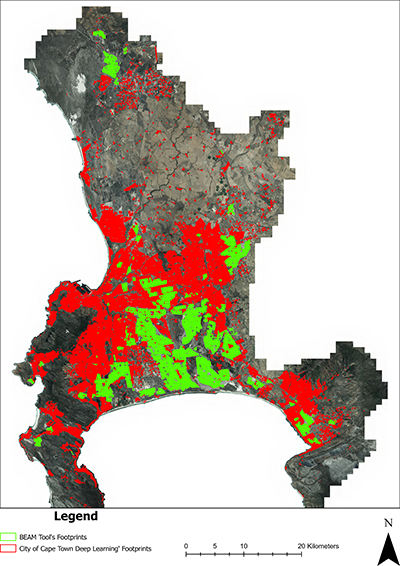In a step towards enhancing data-driven urban management and improving living conditions in rapidly growing communities, the United Nations Innovation Technology Accelerator for Cities (UNITAC-Hamburg) has handed over polygon data of incremental additional dwellings (commonly referred to as ‘backyard’ dwellings) in built-up areas excluding informal settlements, generated by the Building & Establishment Automated Mapper (BEAM) tool to the City of Cape Town.
This collaboration aims to strengthen the municipality’s capacity to understand and respond to the phenomenon of “IADs” — an increasingly common housing trend in South Africa, where formal property owners develop dwellings in their backyard, often renting these to tenants. Incremental Additional Dwellings (IADs) and Small-Scale Rental Units (SSRUs) play a critical role in addressing Cape Town’s housing challenges by providing affordable living options for lower- to middle-income households. Currently these housing typologies make up approximately 20% of total housing stock in Cape Town and are projected to double in number over the next 25 years1. The growth in both these housing typologies is in response to persistent demand for affordable housing which is not met via the formal property market or through government subsidised housing programmes. By providing fast, accurate and up-to-date information on IAD, BEAM provides the fast and accurate polygons of IADs across the City.
IADs can be shacks, wendy houses or simple brick structures, often lacking access to basic services like clean water, sanitation, electricity or public transportation. In Cape Town, "IADs" is one of the fastest-growing housing trends.2 Yet, due to its unstructured and unplanned nature, it is very difficult for local governments to track IADs, consistently reflect those structures in the municipality’s records, and incorporate them into urban planning.
The Building Establishment Automated Mapper (BEAM) was developed by UNITAC-Hamburg as part of an Open Call for projects, funded by the German Ministry of Foreign Affairs. BEAM is an AI-based tool that uses machine learning to automatically map building footprints and structures from aerial imagery for various communal benefits. UNITAC-Hamburg initially developed BEAM in partnership with eThekwini municipality. The initiative responded to a pressing need identified by the city for an automated process to map building footprints of informal areas, enabling data-driven decision-making in urban planning. UN-Habitat Mexico has used BEAM to gain an understanding of the morphological characteristics of informal settlements in Central American cities, such as Guatemala City, Tegucigalpa, Belize City, San Salvador, Santo Domingo, San José, Managua, Panama City.
In 2025, BEAM was deployed in partnership with the City of Cape Town’s Geomatics Branch to better identify IADs despite the extreme density and their overlapping nature. BEAM was applied to publicly available high-resolution aerial photography provided by the city. The tool further enables the monitoring of the expansion of these structures over time, offering a clearer picture of evolving housing patterns.

Photo: buildings mapped using BEAM in Cape Town
With BEAM, 822,390 additional building footprints were detected. The majority of these were IADs, with only a small number of footprints of formal structures that were previously overlooked by the earlier deep-learning model.

Photo: IADs detected using BEAM in green, City of Cape Town’s Deep Learning footprints in red
The BEAM project was recently nominated for the 2025 National Batho Pele and Innovation Awards, a South African government initiative that recognises outstanding public service innovation and excellence in improving service delivery and people-centred governance.
The handover of BEAM’s data output marks a significant step in strengthening the City of Cape Town’s capacity to monitor urban growth and plan equitable services for backyard dwellers and residents of other informal areas. Up-to-date spatial information helps close data gaps and supports efforts to ensure adequate housing and access to basic urban services for those who need them most.
1 Figures provided by the City of Cape Town
2 Local Government Position on Municipal Responses to Backyarders and Backyard Dwellings (South African Local Government Association, 2014)
Published: 13 October 2025

